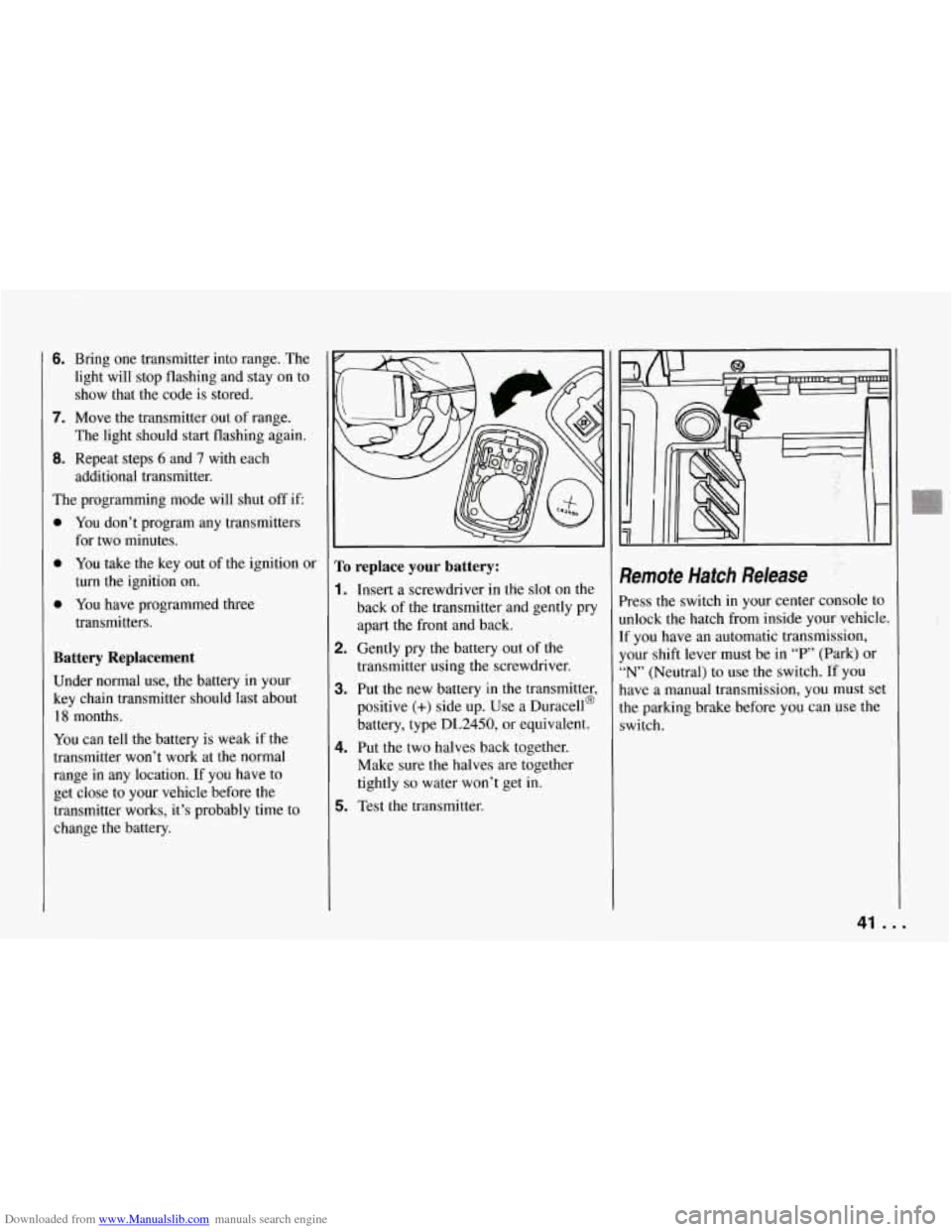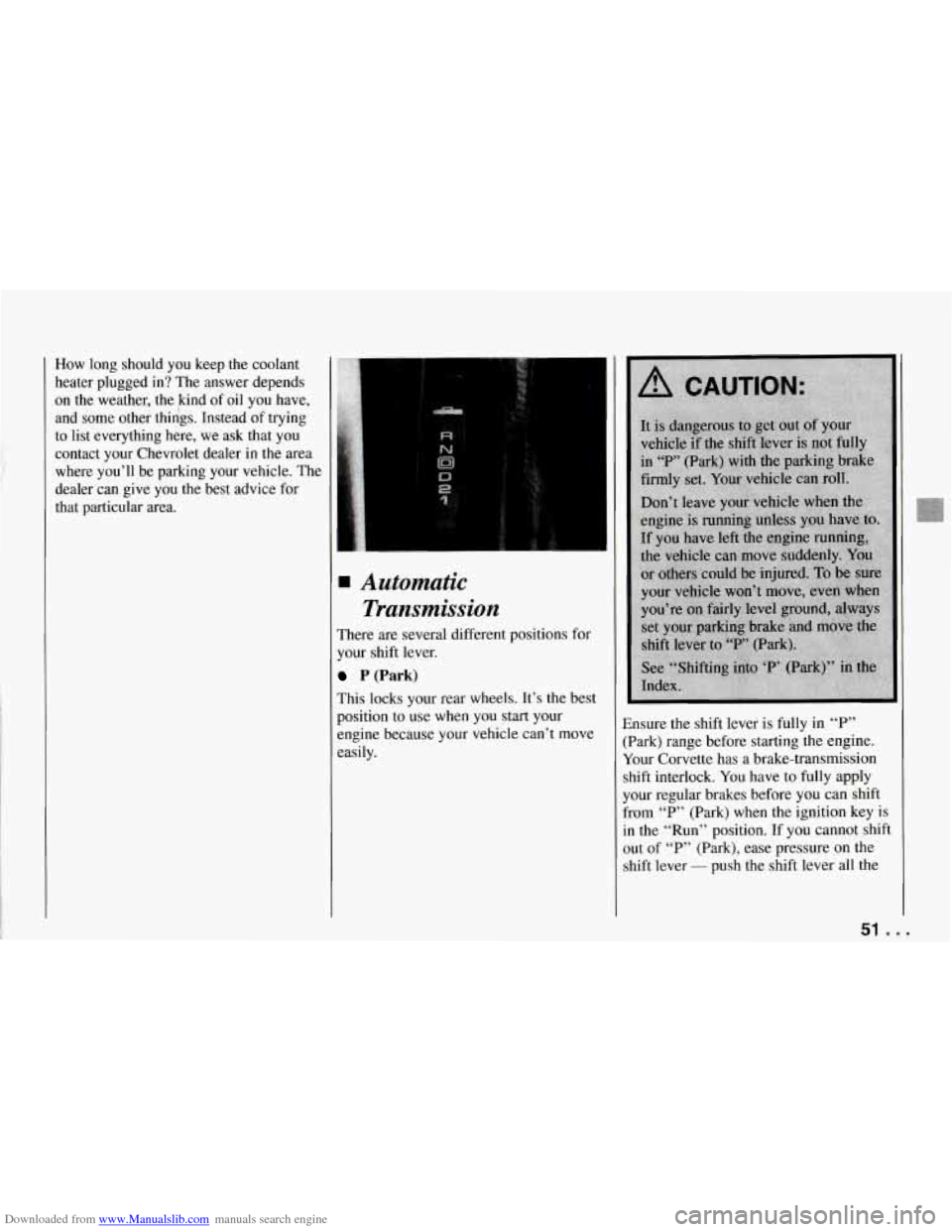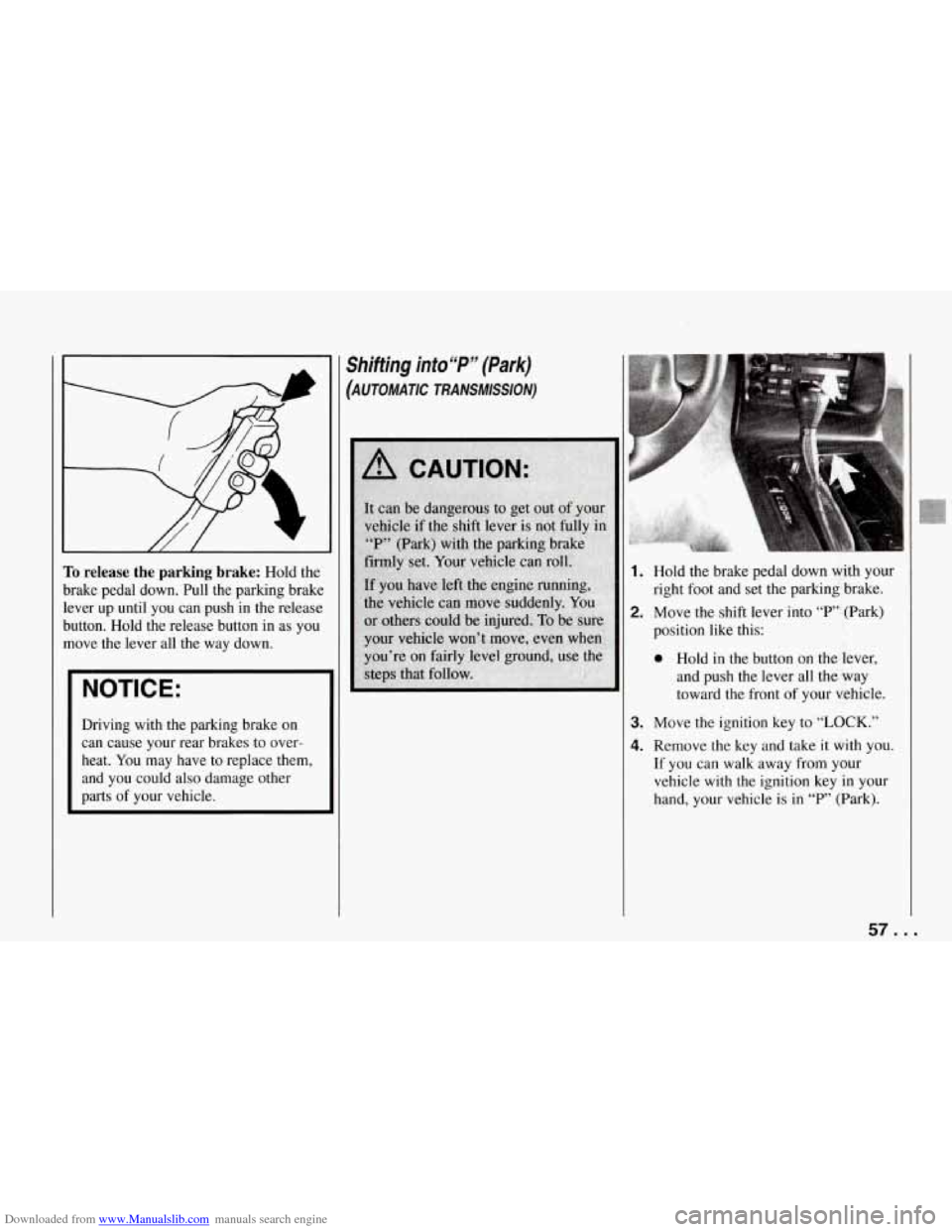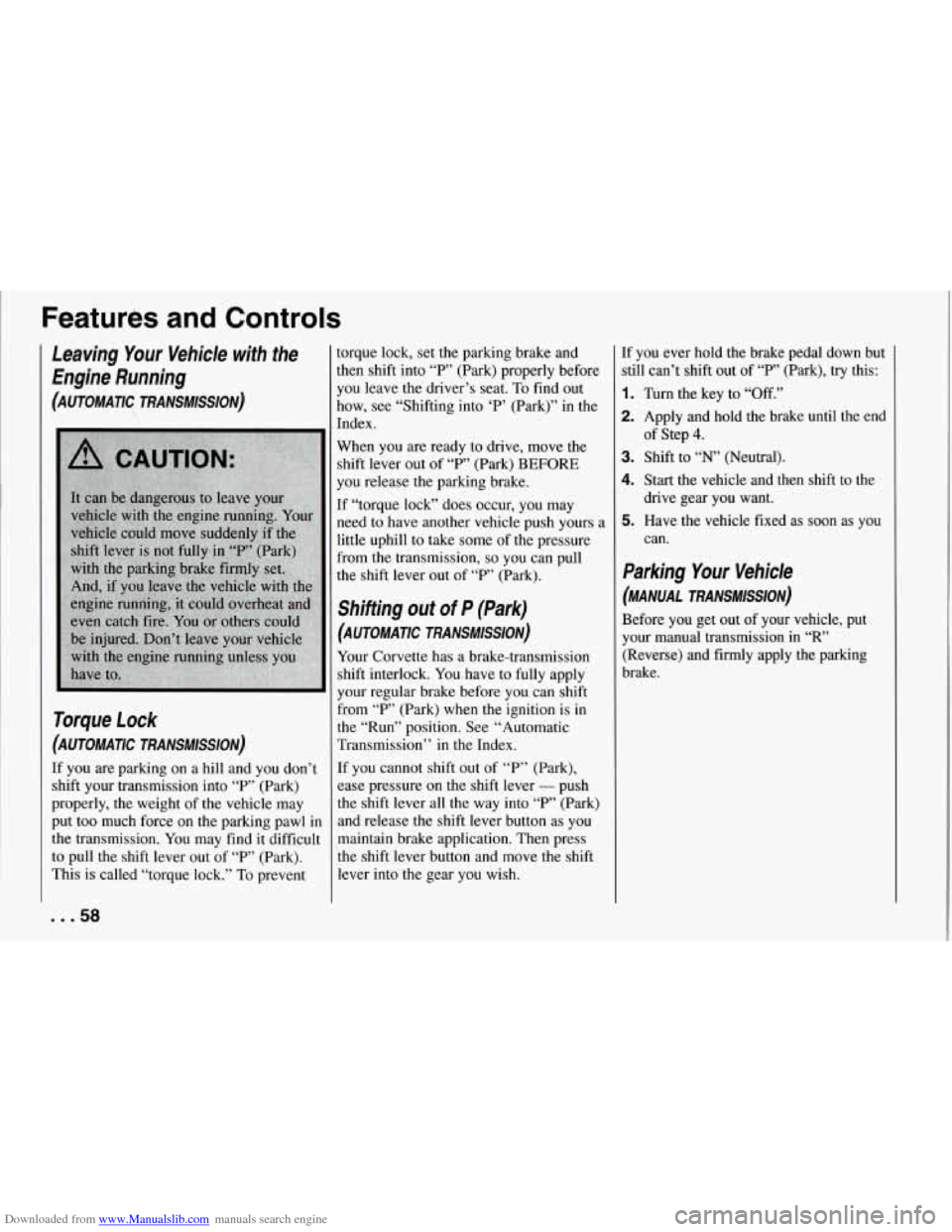1994 CHEVROLET CORVETTE parking brake
[x] Cancel search: parking brakePage 42 of 274

Downloaded from www.Manualslib.com manuals search engine 6. Bring one transmitter into range. The
light will stop flashing and stay on to
show that the code is stored.
7. Move the transmitter out of range.
8. Repeat steps 6 and 7 with each
The programming mode will shut
off if:
0 You don’t program any transmitters
0 You take the key out of the ignition or
0 You have programmed three
The light should
start flashing again.
additional transmitter.
for two minutes.
turn the ignition on.
transmitters.
Battery Replacement
Under normal use, the battery in your
key chain transmitter should last about
18 months.
You can tell the battery is weak if the
transmitter won’t work at
the normal
range in any location.
If you have to
get close to your vehicle before the
transmitter works, it’s probably time to
change the battery.
ro replace your battery:
I. Insert a screwdriver in the slot on the
back
of the transmitter and gently pry
apart the front and back.
2. Gently pry the battery out of the
transmitter using the screwdriver.
3. Put the new battery in the transmitter,
positive
(+) side up. Use a Duracell@
battery, type DL2450, or equivalent.
4. Put the two halves back together.
Make sure the halves are together
tightly
so water won’t get in.
5. Test the transmitter.
?emote Hatch Release
’ress the switch in your center console to
mlock the hatch from inside your vehicle
f you have an automatic transmission,
[our shift lever must be
in “P’ (Park) or
‘N’ (Neutral) to use the switch. If you
lave a manual transmission, you must sei
he parking brake before you can use the
;witch.
..
.i ,
41 ...
Page 51 of 274

Downloaded from www.Manualslib.com manuals search engine Features and Controls
Driving through Deep Standing Water
NOTICE:
If you drive too quickly through deep
puddles or standing water, water can
come in through your engine’s air
intake and badly damage your
engine. If you can’t avoid deep
puddles or standing water, drive
through them very slowly.
Rough Idling
If you notice rough idling or surging,
especially after long periods of idling or
during slow city driving, the oxygen
sensors may be clogged. If this happens,
follow these steps to clear the oxygen
sensors:
1. Set the parking brake.
2. Shift an automatic transmission to “P”
(Park) or a manual transmission to
“N’ (Neutral).
tachometer reads
2,000 rpm and hold
for two minutes.
3. Press the accelerator until your
... 50
Engine Coolant Heater (Engine
Block Heater)
(LTI ENGINE, CANADA)
In very cold weather, 0 “F (- 18 “C) or
colder, the engine coolant heater can help.
You’ll get easier starting and better fuel
economy during engine warm-up.
Usually, the coolant heater should be
plugged in a minimum of four hours prior
to starting your vehicle.
To use the coolant heater:
1. Turn off the engine.
2. Open the hood and unwrap the
electrical cord.
3. Plug it into a normal, grounded
1 10-volt outlet.
I NOTICE:
After you’ve used the coolant heater,
be sure to store the cord as it was
before to keep it away from moving
engine parts. If you don’t, it could be
damaged.
Page 52 of 274

Downloaded from www.Manualslib.com manuals search engine How long should you keep the coolant
heater plugged in? The answer depends
on the weather, the kind of
oil you have,
and some other things. Instead of trying
to list everything here, we ask that you
contact your Chevrolet dealer in the area
where you’ll be parking your vehicle. The
dealer can give you the best advice for
that particular area.
. i:,
Automatic Transmission
There are several different positions for
your shift lever.
P (Park)
This locks your rear wheels. It’s the best
position to use when you start your
engine because your vehicle can’t move
easily. Ensure the shift
lever is fully in
“P”
(Park) range before starting the engine.
Your Corvette has a brake-transmission
shift interlock. You have to fully apply
your regular brakes before you can shift
from “P” (Park) when the ignition key is
in the “Run” position. If you cannot shift
out of
“P” (Park), ease pressure on the
shift lever
- push the shift lever all the
51 ...
Page 57 of 274

Downloaded from www.Manualslib.com manuals search engine Features and Controls
RIDE CONTROL
SPORT
To@F
fl
-
PS c
Selective Ride Control
(OPTION)
This knob is on the center console. Turn i
to select the ride control of your choice:
TOUR: Use for city and highway driving
Provides a smooth, soft ride.
SPORT: Use where road conditions or
personal preference demand more control
Provides more “feel,” or response to the
road conditions.
PERF: Use for performance driving.
Provides tight, firm ride and precise
response to road conditions. ‘TOUR” and “SPORT” will
provide a
imilar ride at low speeds around town,
md both settings will increase control
tnd firmness at higher speeds. “SPORT,”
lowever, will adjust more at ‘higher
;peeds than “TOUR” will.
,‘PERF” will provide much more
Zontrol and a firmer ride at all speeds.
You can select a setting at any time.
Based on your speed,
the system
wtomatically adjusts to provide the best
aide and handling. Select a new setting
whenever driving conditions change.
The “SERVICE
RIDE CONTROL” light
monitors the system. Refer to “Service
Ride Control Light” in the Index.
Limited-Slip Rear Axle
Your rear axle can give you additional
traction on snow, mud, ice, sand or gravel.
It works like a standard axle most
of the
time, but when one of the rear wheels
has no traction and the other does,
the
limited-slip feature will allow the wheel
with traction to move the vehicle.
Parking
Parking Brake
To set the parking brake: Hold the brak
pedal down. Pull the parking brake lever
up, then move it back down. This sets
your parking brake, even though the leve
is down. If the ignition is on, the parking
brake indicator light will come on.
... 56
Page 58 of 274

Downloaded from www.Manualslib.com manuals search engine I // /
To release the parking brake: Hold the
brake pedal down. Pull the parking brake
lever up until you can push in the release
button. Hold the release button in as
you
move the lever all the way down.
NOTICE:
Driving with the parking brake on
can cause your rear brakes to over-
heat.
You may have to replace them,
and you could also damage other
parts
of your vehicle.
Shifting into“P” (Park)
(AUTOMATIC TRANSMISSION)
1. Hold the brake pedal down with your
right foot and set the parking brake.
2. Move the shift lever into “P’ (Park)
position like this:
0 Hold in the button on the lever,
and push the lever all the way
toward the front
of your vehicle.
I 3. Move the ignition key to “LOCK.”
4. Remove the key and take it with you.
If you can walk away from your
vehicle with the ignition key
in your
hand, your vehicle
is in “P” (Park).
57 ...
Page 59 of 274

Downloaded from www.Manualslib.com manuals search engine Features and Controls
Leaving Your Vehicle with the
Engine Running
(AUTOMATIC TRANSMISSION)
Torque Lock
(AUTOMATIC TRANSMISSION)
If you are parking on a hill and you don’t
shift your transmission into
“P” (Park)
properly, the weight of the vehicle may
put too much force on the parking pawl in
the transmission. You may find it difficult
to pull the shift lever out of
“P’ (Park).
This is called “torque lock.” To prevent torque lock,
set the parking brake and
then shift into
“F’” (Park) properly before
you leave the driver’s seat.
To find out
how, see “Shifting into ‘P’ (Park)” in the
Index.
When you are ready to drive, move the
shift lever out of
“P” (Park) BEFORE
you release the parking brake.
If “torque lock” does occur, you may
need to have another vehicle push yours a
little uphill to take some of the pressure
from the transmission,
so you can pull
the shift lever out of
“P” (Park).
Shifting out of P (Park)
(AUTOMATIC TRANSMISSION)
Your Corvette has a brake-transmission
shift interlock. You have to fully apply
your regular brake before you can shift
from
“P” (Park) when the ignition is in
the “Run” position. See “Automatic
Transmission” in the Index.
If you cannot shift out of “P” (Park),
ease pressure on the shift lever
- push
the shift lever all the way into
“P” (Park)
and release
the shift lever button as you
maintain brake application. Then press
the shift lever button and move the shift
lever into the gear you wish. If you
ever hold the brake pedal down but
still can’t shift out of
“P” (Park), try this:
1. Turn the key to “Off.”
2. Apply and hold the brake until the end
3. Shift to “N’ (Neutral).
4. Start the vehicle and then shift to the
drive gear you want.
can. of Step
4.
5. Have the vehicle fixed as soon as you
Parking Your Vehicle
(MANUAL TRANSMISSION)
Before you get out of your vehicle, put
your manual transmission
in “R”
(Reverse) and firmly apply the parking
brake.
... 58
Page 67 of 274

Downloaded from www.Manualslib.com manuals search engine Features and Controls
Passing Another Vehicle While Using
Cruise Control
Use the accelerator pedal to increase your
speed. When you take your foot off the
pedal, your vehicle will slow down to the
Cruise Control speed you set earlier.
Using Cruise Control on Hills
How well your Cruise Control will work
on hills depends upon your speed, load,
and the steepness of the hills. When going
up steep hills, you may have to step on
the accelerator pedal to maintain your
speed. When going downhill, you may
have to brake or shift to a lower gear to
keep your speed down. Of course,
applying the brake takes you out of
Cruise Control. Many drivers find this to
be too much trouble and don’t use Cruise
Control on steep hills.
... 66
:o Get Out of Cruise Control
’here are several ways to turn off the
bise Control:
. Step lightly on the brake pedal or push
the clutch pedal, if you have a manual
transmission;
OR
!. Move the Cruise switch to “OFF.”
ro Erase Speed Memory
Nhen you turn off the Cruise Control or
he ignition, your Cruise Control set speed
nemory is erased.
Operation of Lights
4lthough your vehicle’s lighting system
:headlights, parking lights, fog lamps,
sidemarker lights and taillights) meets all
applicable federal lighting requirements,
2ertain states and provinces may apply
their own lighting regulations that may
require special attention before you
operate these lights.
For example, some jurisdictions may
require that you operate your fog lamps
only when your lower beam headlights
are also on, or that headlights be turned
on whenever you must use your
windshield wipers. In addition, most
jurisdictions prohibit driving solely with
parking lights, especially at dawn or dusk.
It is recommended that you check with
your own state or provincial highway
authority for applicable lighting
regulations.
Page 69 of 274

Downloaded from www.Manualslib.com manuals search engine Features and Controls
Daytime Running Lights (Canada)
The Canadian Federal Government has
decided that “Daytime Running Lights”
(DE) are a useful feature, in that DIU
can make your vehicle more visible to
pedestrians and other drivers during
daylight hours. DIU are required on new
vehicles sold
in Canada.
Your
DRL, work with a light sensor on top
of the instrument panel. Don’t cover it up.
The front turn signal lights will come on
in daylight when:
0 The ignition is on
0 The headlight switch is off, and
0 The parking brake is released.
At dusk, the exterior lights will come on
automatically and the front turn signal
lights will go out. At dawn, the exterior
lights will go out and the front turn signal
lights will come on (if the headlight
switch is
off).
Of course, you may still turn on the
headlights any time
you need to.
To idle your vehicle with the DRL off, set
the parking brake while the ignition is
in
the “Off” or “LOCK” position. Then start
the vehicle. The DRL will stay
off until
you release the parking brake.
... 68
$.
Fog Lights
Use your fog lights for better vision in
Foggy or misty conditions. Your parking
lights or low beam headlights must be
on
or your fog lights won’t work.
To turn the fog lights on, push the button.
Push the button again to turn the fog
lights
off. A light above the button will
come on when the fog lights are on.
Interior Lights
Courtesy Lights
When any door is opened, the interior
lights will go on (unless it’s bright
outside). The lights will stay on for about
30 seconds or until you turn on the
ignition.
Front Map Lights
Your inside rearview mirror includes two
map lights. The lights will go on when a
door is opened. When the doors are
closed and the ignition is on, press the
switch to turn on the lights.